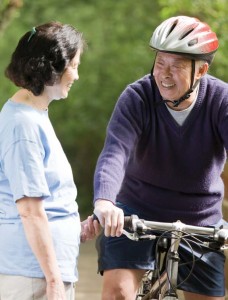March 27, 2013
When you’re a busy caregiver, taking a shower and eating a proper meal might sometimes

feel like a challenge. Making the time to take a walk, go for a swim or hit the gym might seem like a downright luxury.
But in reality, regular exercise should be considered a necessity for caregivers, experts say. “Exercise like other health- promoting behaviors is good for caregivers,” says Richard Schulz, PhD, associate director of the Institute on Aging at the University of Pittsburgh. “However, due to the demands and stresses of caregiving, exercise, like other self-care behaviors, is often neglected.”
Adds Barbara Bushman, PhD, editor of ACSM’s Complete Guide to Fitness & Health (2011, Human Kinetics) and a professor of kinesiology at Misouri State University, “I can’t think of a more important group that needs to take care of themselves. They need to take care of themselves first in order to take care of the person they love.”
The Perks of Exercise
Exercise does wonders for your physical health by improving strength and balance, making it easier to perform daily activities. It also helps rev up your metabolism. “As you get older, your metabolism gets slower,” Bushman says. “We have less muscle mass and higher body fat. Some of that is due to decreases in activity, and some is due to the aging process. Less muscle mass means we need fewer calories for over-all body weight.”
The right combination of exercises can also help maintain your flexibility, and maintain healthy heart and lung functioning.
Regular exercise has psychological benefits too, and is a good antidote for depression that often comes with caregiving. Research has found that caregivers who exercised 30 minutes three times a week had less stress and depression. “Regular activity enhances your mood state, and has social benefits if you do it with others,” Bushman says. “It’s a huge stress reliever. It also reduces anxiety and in the long- term, promotes improved feelings of well-being.”
Exercising regularly can also slow age-related cognitive declines, improve the way your brain processes information and preserve motor control for more precise movement. “With exercise, we’re helping to not lose those capabilities as quickly,” Bushman says.
Get Down to It

make a habit of it.
Knowing that exercise matters is one thing, but actually doing it is another. The key is placing value on exercise and recognizing that it’s important not only for you, but your loved one. “You have to go back to what you value and really grab onto what the benefits are and then really enjoy what you are doing,” Bushman says. “Hopefully you’re doing things that not only make you feel better tomorrow, next week or next year, but it should feel really good to you right now.”It also helps to change your perspective on exercise. Instead of saying “I can’t fit this into my schedule,” say, “I will fit this into my day,” Bushman suggests. “You change your perspective to set the habit,” she says. “Once you’ve set the habit, it will seem strange when you don’t do it.”
Even with all the new ways of thinking, making room in your life for exercise isn’t easy. “Finding the time for exercise is a major challenge,” Schulz says. “An ideal scenario would be to combine exercise with respite, and have someone else care for the patient while the caregiver takes an exercise break.”
The other challenge to overcome, he says, is exhaustion. Caregivers are often too tired physically and emotionally to do any exercise. Schulz says that finding respite could also help with that.
For those who haven’t exercised in a while, figuring out what to do can be difficult. Here are some tips to get you started:
- Set some goals. Create distinct and measurable goals on what you plan to do. It might be taking a 10 minute walk after breakfast every day, or doing hand weights during commercials for your favorite hour-long TV show twice a week. “Goal setting is vital for everybody,” Bushman says. “Without them, it’s like starting out on a road and not know- ing where you’re going.”
- Write it down. Bolster your commitment by putting your plans on paper. Schedule it on your calendar as you would any other appointment. Then keep a log of what you do each day, so you can map your progress.
- Work toward total body conditioning. To get the most from exercise, work up to doing a cardiovascular workout three to four times a week, strength training twice a week, balance training two or three times a week and flexibility at least twice a week. Visit www.easyforyou.info for more ideas on specific exercises.
- Check out your options. Be open to different ways of exercising. Consider checking out classes at the local gym, senior center or YMCA for a more social workout. If you prefer exercising at home, looking into purchasing or borrowing exercise DVDs or investing in a treadmill or stationary bike.
Whatever you decide to do, the key is to be active—and to enjoy it. “If you’re walking around the neighborhood, enjoy the scenery,” Bushman says. “If you’re walking at the mall, enjoy the social interaction. You have to really enjoy what you are doing.”
By Winnie Yu











